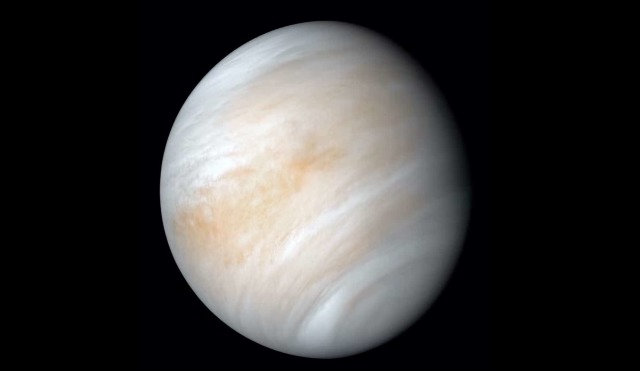Space agencies plan to launch spacecraft to Venus in the late 2020s. Private companies are not lagging behind: their missions can reach the orbit of the second planet farthest from the Sun much earlier. Naked Science talks about these projects and reflects on why they have a chance of success.
Our nearest neighbor Venus is a mysterious, contrasting and alluring planet. The sunlight in its orbit is twice as hot as on Earth, but Venus is completely covered with clouds that reflect 76 percent of the radiation back into space. Therefore, Venus, despite its proximity to the Sun, gets even slightly less of its energy than the Earth.
Clouds hide the surface from terrestrial telescopes, and scientists and science fiction writers who worked before the era of space research could not find out what was on it. They imagined a world entirely covered with tropical forests and swamps, in which unhurried giants, similar to ancient terrestrial fauna, roam under the continuous rain.
Looking ahead, we note that if the atmosphere of our nearest neighbor was similar to that of Earth, it would most likely be so.
Broken dreams
With the advent of the era of space flight, the hopes of scientists evaporated like morning dew. Astronomers have guessed since the discovery of Lomonosov that the Venusian atmosphere is more massive than the earth, but underestimated its density. Soviet researchers began launching probes to Venus in 1965, strengthening their design with each failure, but the atmosphere of this planet crushed the first vehicles one by one.
Finally, in 1970, the device " Venus-7 " was the first in history to reach the surface of Venus in one piece. He directly measured the conditions on the surface: the temperature is 475 degrees Celsius, the pressure is 92 times higher than on Earth. Water vapor in the atmosphere is tens of thousands of times less than water in the earth's oceans, the ground is solid fields of frozen lava, the dull orange sky gives illumination comparable to a cloudy day on Earth.
The high temperature is provided by both the density of the atmosphere itself (which you can read about in detail here ) and the greenhouse effect of carbon dioxide, which acts as the main component of the Venusian atmosphere. There is 96.5% of it, or, taking into account the pressure, 200 thousand times more than in the Earth's atmosphere. And the sparkling clouds, thanks to which ancient people considered the brilliant planet to be the embodiment of love and beauty, turned out to consist of concentrated sulfuric acid.
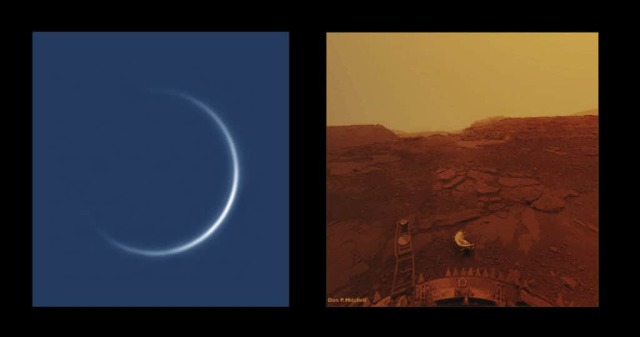
The brightest manifestation of the contrast between the shell and the contents among the planets of the Solar system
Image source: Bernd Koch. Image of the surface transmitted by Venus-13 — processed by Don Mitchell
It became clear that the Venusian landers would not meet not only venerosaurs, but even primitive life forms. On its surface, as well as in the atmosphere under the cloud layer, it is too hot for any terrestrial organisms.
They say that when Soviet researchers discussed the data of Venus-4, which was the first to penetrate deep into the Venusian atmosphere and transmit a temperature of 262 degrees Celsius at an altitude of 28 kilometers, one of the designers could not hold back tears.
Gleb Maksimov, leading developer of spacecraft automation
After such discoveries, the exploration of Venus quickly came to naught. The last landing and atmospheric missions reached our nearest neighbor in 1985. After that, only three vehicles worked in its orbit — the American Magellan, the European Venus Express and the Japanese Akatsuki .
But surprisingly, over time, new data made scientists doubt that Venus is a completely dead world.
Signs of the "impossible"
Has Venus always been dry? No. When analyzing the composition of the Venusian atmosphere 630" target="_blank" rel="nofollow">it was found that the relative deuterium content in it is 150 times higher than that of Earth. This heavy isotope of hydrogen is concentrated in the atmosphere when water escapes into space, and this colossal enrichment means that once there was only slightly less water (or steam) on Venus than in Earth's oceans.
Could the water be liquid? Yes! With the current dense atmosphere, this is impossible, but the amount of carbon dioxide in the atmosphere of Venus roughly corresponds to its content in all terrestrial carbonate rocks. If the initial composition of Venus was similar to Earth's, then earlier carbon dioxide could be bound into carbonates on it, and the atmosphere was much less dense.
Modeling of the climate of ancient Venus shows that billions of years ago, when the Sun's luminosity was lower than today's, its climate could have been even cooler than Earth's. This is made possible by the peculiarities of atmospheric circulation on slowly rotating planets (Venus rotates around its axis for 243 Earth days, and the solar day on it lasts 117 earth days: two earth months the night lasts, the same amount — the day). But something went wrong: the atmosphere became denser, water vapor and carbon dioxide began to flow into it, increasing the greenhouse effect.
The heating that began closed a vicious circle: hypothetical oceans evaporated, carbonates threw all the carbon dioxide they associated into the atmosphere, and Venus turned into a world burned to the ground.
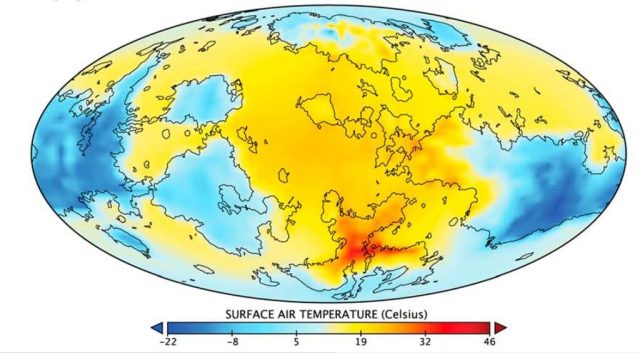
Simulated temperature map on the surface of Venus under the following conditions: the atmosphere coincides with the earth's, the luminosity of the Sun is 77% of the current one (corresponds to the time 2.9 billion years ago), there is an ocean with an average depth of 310 meters on the surface (which corresponds to the current content of deuterium in the atmosphere of Venus). The slow rotation of Venus around its axis reduces the efficiency of atmospheric circulation. Therefore, the day side is almost entirely covered with clouds reflecting sunlight, and the night side is clear, effectively radiates heat into space. The average temperature is plus 11 degrees Celsius (three degrees lower than on modern Earth), and the maximum is plus 36. With a faster rotation (one rotation around the axis in 16 Earth days), the circulation increases. On the daytime side, partly cloudy weather is established, the average temperature rises to plus 46 degrees, and the minimum does not fall below plus 27. On the contrary, if you "raise" the luminosity of the Sun from 77% to 94% during slow rotation, it becomes even more cloudy on the daytime side, and the temperature rises by only four degrees
Image source: https://agupubs.onlinelibrary.wiley.com/doi/epdf/10.1002/2016GL069790
Some details of the landscape of Venus can store evidence of ancient, temperate times. Surface radar and exploration Its emissivity in the infrared range by the Magellan and Venus Express probes showed that not the entire planet is covered by fields of frozen lava. Venusian tesserae, elevated areas of the surface, are similar in morphology and mineral composition to the remains of continents crumpled by lithospheric deformations. These landforms could have formed during tectonics on a planet with oceans (see also the third section in this note).
Geological map of Venus, compiled by specialists of the Russian Academy of Sciences in 2010
And if life on Venus simply did not originate? It's okay, the planet could still be inhabited. There are a number of highly underestimated studies that have studied and modeled the transfer of material between planets during asteroid bombardment. Asteroid impacts knock out a huge amount of rocks into space, and some of the material ends up on other planets. Unicellular organisms and their spores can survive such a journey and take root on another planet — this supposed and probable way of spreading life between planets is called lithopanspermia .
In fact, if we find Martian meteorites on Earth, then Mars and Venus must be full of terrestrial meteorites. For billions of years, many large asteroids have fallen on our planet — Chikshulub alone knocked hundreds of millions of tons of terrestrial rocks saturated with microorganisms into space. Therefore, earthly life could well have sprouted on Venus, and also on Mars and wherever it could take root.
There was a period in the Solar System, 3.2-3.8 billion years ago, when as many as three neighboring planets — Venus, Earth and Mars — could simultaneously have a temperate climate, and one of them — Earth — definitely had life. Asteroid bombardment in those days was more intense than modern, and lithopanspermia was quite capable of combining their biospheres into one.
Well, Mars, the reader will say, but the Venusian sector of the biosphere of the Solar system was definitely supposed to remain in the past? But not really. Venus is hot only under clouds. As on Earth, the temperature drops by several degrees with every kilometer of altitude, and there is a layer in the clouds of Venus where the temperature is like outside our window, and the pressure is slightly lower than Earth's.
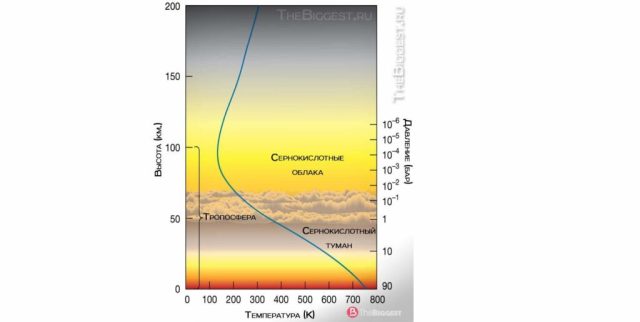
The dependence of temperature and pressure in the atmosphere of Venus on altitude. Degrees on the Kelvin and Celsius scales are equal to each other, and the scales themselves are shifted by 273.15 degrees. The freezing point of water is 273.15 degrees Kelvin, boiling (at atmospheric pressure) is 373.15 kelvin, and outside the window at the time of writing these lines was 291 degrees Kelvin — it's cool for summer
The volcanic sulfuric acid composition of clouds has long forced scientists to refrain from speculating about their possible habitability. But when studying the Venusian atmosphere from Earth and orbiters, they found difficult to explain and interesting phenomena.
In the clouds, just in the temperate layer, there is a strong absorption of ultraviolet radiation from the Sun, and none of the known gases in the atmosphere of Venus is able to provide just such absorption. But its spectrum is similar to the absorption of ultraviolet light by some terrestrial microorganisms. The absorption regions are dynamic: they drift through the clouds, disappear and spread again, resembling algae blooms in the ocean.
The impurity gases found in the atmosphere — sulfur dioxide, carbon monoxide, oxygen, ammonia, hydrogen sulfide and other compounds — are poorly compatible with each other. Among them there are oxidizers and reducing agents, acidic and basic compounds. Their simultaneous presence in the atmosphere (even in impurity quantities) requires the presence of complex nonequilibrium processes that continuously generate each of them. And a recent study of the atmosphere of Venus revealed an admixture of phosphine in it. This gas, a poisonous compound of phosphorus with hydrogen PH3, is released in trace amounts by anaerobic organisms, but on rocky planets it is very difficult to "get" it in other ways.
Phosphine and other biosignatures
When, at the beginning of the XXI century, the finds of planets from other stars began to number in the hundreds and thousands, scientists seriously thought about how life could be discovered on worlds that would not be available for direct research for a long time. It is necessary to proceed from the composition of the atmosphere, which can be found out by spectroscopy methods.
Careful selection among possible atmospheric components has revealed several candidates for biosignatures — molecules or combinations of them that are unlikely to appear on sterile planets and that can be detected by spectroscopic observations from the Solar System. The issue of biosignatures is complex and ambiguous; you can read more about it, for example, en/biosignly-ekzoplanet/" target="_blank" rel="nofollow">here . But the combination of oxygen with methane and, in fact, phosphine were recognized as one of the best spectroscopic biosignatures in the atmospheres of rocky planets.
Before directing telescopes to exoplanets, scientists honed methods for detecting biosignatures on planets of the Solar System. Quite a lot is known about their atmospheres, and this allows us to properly deal with possible sources of false signals. What was their surprise when they discovered that there is phosphine on Venus (for more information about this discovery, see here )
All this eventually led researchers to the idea that the Venusian clouds, despite their extreme acidity, may be inhabited by microscopic life forms akin to terrestrial bacteria that enter the upper layers of our atmosphere. In the earth's stratosphere, there are also droplets of sulfuric acid, and bacteria raised by winds from the surface.
Venusian life could "move into the cloud" and persist there when the surface lost all habitability. At the same time, the acidity of modern Venusian clouds still exceeds the acidity of the most extreme environments on Earth.
If there really is life in them, this find will rewrite the ideas about the adaptability of living organisms. And its study will shed light not only on the most important questions about the origin and spread of life, but also on the history of the planet.
A short animation of the dynamics of an ultraviolet absorber in the clouds of Venus, / © JAXA / ISAS / DARTS / Roman Tkachenko
It is not surprising that in the last few years, interest in exploring Venus has grown, and now four large research expeditions are planned for it at once. Recently, another interesting project has been added to them, and in the next part of the article we will talk about the "new wave" of spacecraft that will soon rush to the second planet of our system.
NASA — VERITAS and DAVINCI missions+
Let's start with the VERITAS spacecraft, which is scheduled to launch in 2028. Its main objectives will be radar mapping and surveying the surface of Venus using a synthetic aperture radar with a resolution of up to 15-30 meters. Thus, it will become the successor of the Magellan device, which conducted a similar survey with a resolution of 300 meters in the early 1990s.
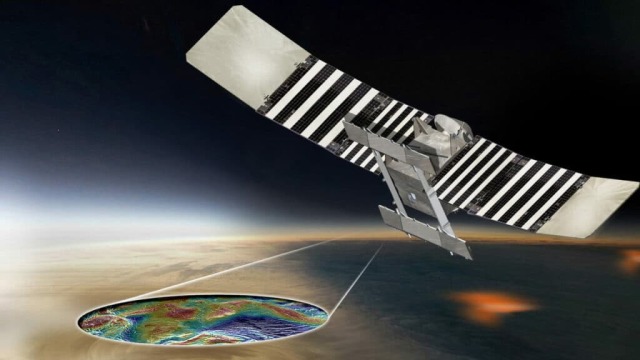
Artistic image of the spacecraft "VERITAS" in the orbit of Venus
Image Source: NASA
VERITAS will be able to detect all the changes that have occurred on the Venusian surface since the time of Magellan, and possibly register new movements in real time. To do this, it will carry out repeated measurements of surface heights, at which it is possible to track their change with relative accuracy up to 1.5 centimeters. Thus, VERITAS will provide a convincing answer to the question of the presence and intensity of modern geological activity on Venus.
In addition, VERITAS will be equipped with a near-infrared multispectral imaging system using infrared " transparency windows " of the atmosphere. By the reflectivity and emissivity of rocks at these wavelengths, it is possible to determine their types (basalts, granites and other groups) and to map the distribution on the surface.
In addition, VERITAS will for the first time build a detailed map of the gravitational field of Venus, with the help of which it will clarify its internal structure — the nature and thickness of the main shells, as well as the heterogeneity of the lithosphere. To do this, an atomic clock will be installed on the device, according to which scientists will be able to track its orbital trajectory with ultra-high accuracy and study the gravitational potential based on registered deviations.
DAVINCI+ will be launched a little later, in 2029-2030, it will become the first device in almost half a century to reach the surface of Venus (in working condition). He will descend to one of the tesserae — the supposed remnants of the Venusian continents — and conduct a detailed aerial survey of it.
Scheme of descent of the landing vehicle "DAVINCI+"
Image Source: NASA/GSFC
But the main task of DAVINCI+ is a comprehensive study of the composition and conditions of the lower Venusian atmosphere during a slow descent through it. To do this, a compact gas mass spectrometer will be installed on it, as well as a laser spectrometer with a tunable wavelength, similar to the device on the Curiosity rover. These instruments are designed to detect trace components of the atmosphere in ultra-low concentrations, as well as to measure its isotopic composition, which will tell a lot about the origin and evolution of the planet's atmosphere.
A multispectral camera will be installed on the orbiter that will deliver the DAVINCI+ lander to Venus and transmit its data to Earth, taking pictures in the windows of atmospheric transparency and complementing the VERITAS data.
European Space Agency Mission — EnVision
This flagship expedition to study the surface and atmosphere of Venus, scheduled for launch in 2031, will complement and expand the capabilities of NASA spacecraft. EnVision will be equipped with two whole radars. One of them is similar to the VERITAS radar (what to do, at the planning stage, no one assumed that both NASA research stations would also fly), and the other, long-wave, will look under the surface of Venus and explore the Venusian stratigraphy and properties of subsurface minerals.
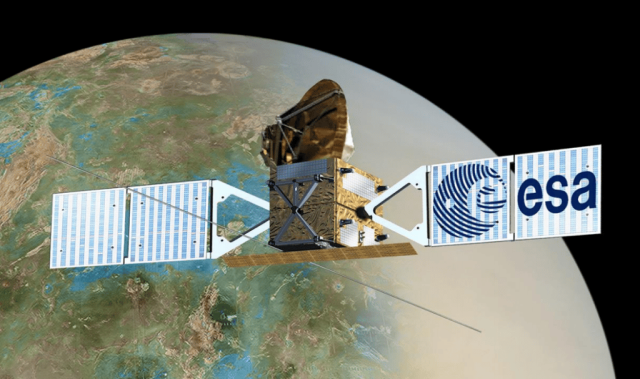
An artistic image of the EnVision spacecraft orbiting Venus, showing the size of radar antennas.
Image Source: ESA
The remaining instruments will be engaged in comprehensive spectroscopic studies from orbit in the ranges from ultraviolet to infrared. EnVision's research program is extensive: the study of the dynamics of the impurity components of the Venusian atmosphere and the variability of conditions on the surface, the climate of Venus, the search for volcanic eruptions, the study of surface mineralogy.
In addition, the ultraviolet spectrometer will study the properties, propagation and dynamics of the regions of the same ultraviolet absorber in the clouds.
"Venus-D"
Russian space researchers are also planning to make a new contribution to the study of Venus. Spacecraft " Venus-D " ("D" — long-lived) is supposed to be launched at the end of 2029 and, as its name implies, will deliver to Venus a surface station capable of working on the surface of the planet longer than its predecessors.
This device is not a competitor to the NASA probe, which is aimed mainly at atmospheric research and aerial photography. The main goal of DAVINCI+ is a high—precision direct analysis of atmospheric gases, and whether it will reach the surface and work on it for some time is good. "Venus-D", on the contrary, is designed to inherit and expand the successes of Soviet scientists on the very surface.
As part of the project, it is planned to create a lander that will land in the Tesser mountain landscape and live on the surface for at least three hours. He will conduct a direct and high—precision chemical, mineralogical and radiological analysis of surface rocks - that is, he will do everything that cannot be done from orbit or from the air.
One of the planned devices — a pulsed neutron gamma-ray spectrometer — will use a pulsed neutron source, which is an original Russian development and installed on the Curiosity rover (there it searches for hydrogen hiding in the soil, but the principle itself is also suitable for measuring the content of other elements).
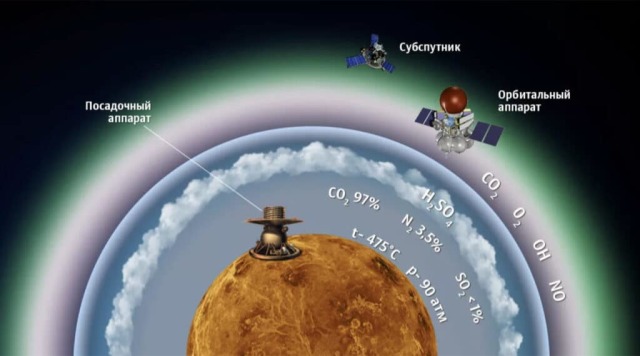
The concept of the Venus-D mission
Image source: S. A. Lavochkin NGO
On the way to the surface, the device will also study the atmosphere. In particular, he investigates aerosols of the middle and lower atmosphere, in which the previous descent vehicles came across mysterious irregularly shaped particles.
Due to the current situation, the plans involve risks, and it is unclear in what configuration and when this expedition will fly. One of the options included a lander with a service life of 90 Earth days, which, among other things, will study Venusian seismology and demonstrate technologies suitable for long-term operation on the most extreme surface of the Solar System.
Another advantage of Venus-D is its trajectory. A direct flight to Venus takes several months, but must begin in the "launch window" in order to achieve minimum fuel consumption (or rather, the maximum delivered mass for the launch vehicle used). The date of arrival to the second planet also turns out to be "nailed down".
Since Venus rotates around its axis very slowly, and the entry into the atmosphere is carried out only tangentially, while only small areas of the surface are available for each launch date. Going beyond them, while maintaining a straight flight path, requires avoiding the optimal trajectory and significantly increases fuel consumption.
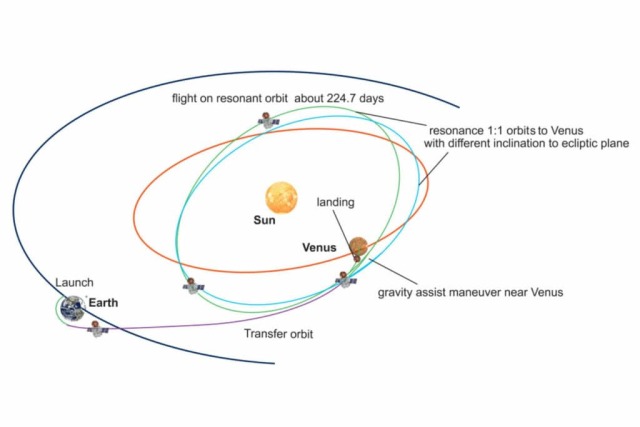
The proposed trajectory of Venus-D. Transfer orbit is the first stage of the flight (optimized for fuel). From it, you can go both to landing or orbit (as all other devices do), and to a gravitational maneuver. Orange shows the orbit of Venus, and green and blue — two options for an additional orbit, differing from it by the inclination of the orbit. Each inclination corresponds to its own landing areas, and the entire available range of inclinations allows you to "cover" almost the entire surface of Venus
Image source: ICI RAS
"Venus-D" will first fly past Venus and perform a gravitational maneuver at it, which will send the device to an additional revolution around the Sun. Its parameters — and, therefore, the landing areas available "at the finish" — can be selected within very wide limits. This is one of the main properties of gravitational maneuvers: a small shift in the flight path significantly changes the entire subsequent trajectory.
At the same time, the trajectory before the maneuver remains almost the same and very close to optimal — therefore, you will not have to pay for the "opening" of previously inaccessible landing sites with fuel consumption or cutting the mass of the device and its payload.
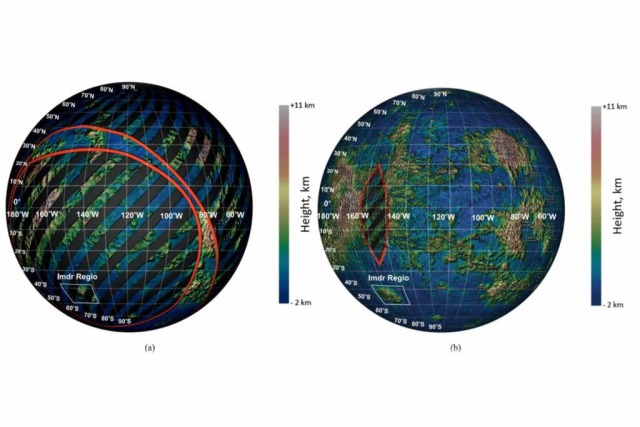
Hatching indicates areas on Venus that are inaccessible when launched in 2029 along a straight trajectory (left) and with a gravitational maneuver (right). The color shows the height from the average level (-2 to 11 kilometers)
Image source: ICI RAS
Indian Mission "Shukrayan-1"
Recently, the Indian Space Agency was noted for its phenomenal success: in 2013, it launched an orbiter on its own rocket " Mangalyan ". He flew to Mars on the first attempt (no one else was able to do it) and completed his task, and all this was only $ 73 million. Mangalyan became the cheapest expedition to the Red Planet in the history of cosmonautics (adjusted for inflation).
It is not surprising that the Indians are not going to stay away: in December 2024, they plan to launch an apparatus to Venus " Shukrayan-1 ". Little is known about the purposes of this device, but it follows from the list of planned devices that it will study the dynamics of the atmosphere and the processes of its volatilization into space, as well as engage in high-resolution surface radar.
But what about life?
The plans of space agencies are really impressive (at least, in comparison with the previous half-century stagnation). In the 2030s, we are highly likely to find out the answers to all modern questions about the planetary science of Venus - its geology, meteorology and evolution… Except for one thing.
As it is easy to see, exobiologists may look at these prospects with some frustration. Four large missions that will start no earlier than the end of the decade, one of them largely duplicates the other two — and none will engage in a direct search for life. Private companies, which have long been aiming at exploring neighboring celestial bodies, looked at this case and decided: there is nothing to beat around the bush. Down with procrastination, let's fly now.
Venus Life Finder: Straight into the clouds
A group of researchers, including well-known exoplanetologists Sarah Seeger from the Massachusetts Institute of Technology and David Grinspoon from the Planetary Science Institute, has developed the Venus Life Finder project. The main goal will be the search for life in the Venusian clouds. Recently, they enlisted the support of the private space company Rocket Lab and started the active phase of the project.
Rocket Lab will provide funding for the first vehicle of the program, launch and launch facilities — Electron rocket and Photon satellite chassis. A detailed description of the entire Venus Life Finder program is publicly available here, its materials were actively used in the preparation of this article.
Since the payload capacity of the rocket is much inferior to heavy carriers, and "speed is above all", the spacecraft will have to be made small and rely not on the power of many devices of the highest class, but on its own ingenuity and ingenuity. The developers of Venus Life Finder have enough of it. After conducting preliminary research and design, they came to the conclusion that they would be able to meet the output weight of 20 kilograms and the launch date in 2023.
To substantiate the main idea, the scientists conducted four experiments, each of which is elegant, simple and complements the others. Let's describe all four here — it's worth it.
Experimental substantiation of the search for life in the clouds of Venus
Biological molecules and their components can be detected by their fluorescence, which is assumed by the Venus Life Finder working method. Will the method work in the atmosphere of Venus? Scientists dissolved biomolecules in sulfuric acid, simulating the clouds of this planet, and showed that their fluorescence persists up to a concentration of 70%.
Can biological structures be stable in a super-acidic environment? Scientists have studied the stability of lipid micelles of various compositions. Terrestrial cells in such an environment, of course, are destroyed, but the experiment showed that some alternative lipids are able to form micelles in 70% sulfuric acid. Thus, the main structural element of terrestrial life can also exist in the Venusian clouds.

Fluorescence of fluorescein solutions in sulfuric acid solutions. The concentration is indicated in moles per liter; 0.1 M corresponds to a concentration of 0.98%, at higher concentrations, the dependence of the mass fraction on the molarity begins to deviate from the linear one due to an increase in the density of the solution. Since the wavelengths of fluorescence of biomolecules also depend on acidity, scientists need to know the true degree of acidity of cloud particles (which depends not only on the concentration of acid, but also on impurities of other compounds). To do this, plates covered with a thin layer of fluorescein and intercepting aerosol droplets will be installed in one of the subsequent atmospheric probes, as in the photo on the right. By the color of the fluorescence of the emerging spots, it will be determined what acidity the drops have and what is its distribution
Image source: https://venuscloudlife.com/wp-content/uploads/2021/12/VLFReport_12092021.pdf
Macromolecular components of terrestrial life, on the contrary, do not survive encounters with concentrated sulfuric acid. Every chemist knows how caustic it is, but meticulous researchers have approached the issue scrupulously. They confirmed that proteins, carbohydrates and nucleic acids of terrestrial organisms that have never encountered 70 percent sulfuric acid in the course of their evolution quickly disintegrate in it and lose their ability to pollute instruments and the Venusian atmosphere.
Finally, the project team repeated Miller's experiment — Yuri in an environment that mimics the clouds of Venus. In this experiment, a mixture of gases containing methane, ammonia, hydrogen and carbon monoxide is placed in a closed stirred volume containing also water and is exposed to electrical discharges. After some time, amino acids appear in the mixture — structural units of proteins and other simple biomolecules. Now scientists have discovered that this happens in the presence of concentrated sulfuric acid.
Of course, the experiment does not prove that life could "originate in a cloud", and not be brought there from the surface. If more complex molecules are formed from simple molecules, then they are definitely not similar to terrestrial complex biomolecules, because the previous experiment showed their instability in the Venusian clouds. But this result reinforces the very idea of the "habitable zone" of the Venusian atmosphere. This environment is not so hostile; otherwise, organic molecules in it would disintegrate, and not form.
The third point here should be noted separately — this is a very important point in planetary exploration. The main obstacle to the search for life on Mars is precisely the possibility of contamination of the planet and instruments with terrestrial life. Experiments conducted on another planet cannot just be double-checked, so scientists strive to be as sure as possible that their future finds did not arrive on Mars together with the rover.
In addition, they try to prevent the spread of terrestrial life to Mars (although the lithopanspermia mentioned above makes this logic controversial). Therefore, the rovers undergo a complex and demanding sterilization procedure before launching. On Venus, as we now know thanks to the Venus Life Finder team, there is no need to take care of this at all.
That's what fresh thinking means — not in the eyebrow, but in the eye!
Convinced of the validity of the idea, scientists have developed a single device capable of registering the presence of cells in aerosol particles and determining some of their properties. This is a fluorescent nephelometer — a device that irradiates aerosol particles with an ultraviolet laser. The detector of the device will measure the scattering of laser radiation on particles, which can be used to determine their size, shape and structure, and register their fluorescence.
The results will be compared with the reference data obtained in terrestrial experiments with biomolecules and micelles in sulfuric acid. Devices of this type can be made compact, and the mass of the lander, together with the device and the communication system, will be only a kilogram. The total cost of launch and development has not yet been made public, but the cost of the Electron rocket today is about 7.5 million dollars.

The scheme of the autofluorescence nephelometer. An ultraviolet laser shines through a window in the body (aircraft skin) of an atmospheric probe. Passing aerosol particles scatter laser light, give it polarization (linear in the case of round particles and elliptical in the case of irregular shape) and cause their fluorescence. The second window and collecting lenses direct all this radiation to the recording devices (an avalanche photodiode is shown)
Image source: https://venuscloudlife.com/wp-content/uploads/2021/12/VLFReport_12092021.pdf
Afterword
Here you can see that two additions are being asked for in the design of the probe and in preparation for its launch.
Firstly, a modern digital optical microscope can be made very compact — weighing literally a dozen grams. The developers are thinking about installing a camera on the first probe, but so far they have not decided either on its presence or on the goals. And she may be useful. The chemical processes of the Venusian clouds and the atmosphere hiding under them have no terrestrial analogues, and it is impossible to exclude the possibility of unforeseen sources of false-positive signals.
What could be a better confirmation of the data than a series of microphotographs of aerosol particles with cells inside stuck to the glass? And what could be more disappointing than to find out many years later that crystals of some "non-obvious" compound fall into the aerosol, which can never exist in the earth's oxidizing atmosphere and which creates both "biological" fluorescence and the non-spherical shape of droplets?
Secondly, the sunlight reaching the clouds of Venus contains a lot of ultraviolet (we would not be able to detect an ultraviolet absorber if this were not the case). Perhaps detailed spectroscopic studies of Venus using powerful terrestrial telescopes will allow us to identify from our planet not only the absorption, but also the fluorescence of the ultraviolet absorber, isolating it from reflected sunlight — and thereby better prepare for experiments in the clouds of Venus.
As the project develops, the researchers plan to launch a whole series of vehicles to the second planet. Each of them will start shortly after the completion of the previous one and take into account its results. Subsequent launches include balloon probes with a service life of up to two weeks, equipped with instruments for accurate isotope and elemental analysis: a laser spectrometer with tunable frequency and a miniature optical emission spectroanalyzer.
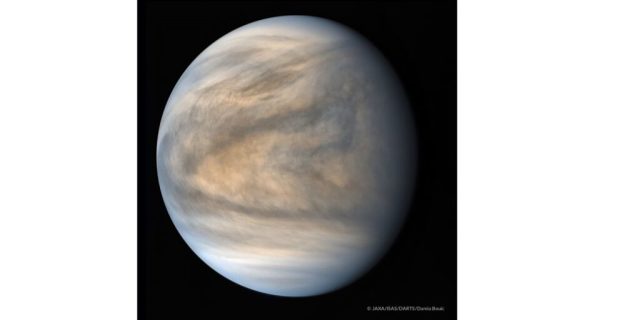
The image of Venus as we would see it if we perceived near ultraviolet. Yellow and dark gray areas have a high concentration of ultraviolet absorber. The atmosphere in the image rotates "from left to right". At dawn, the absorption is small, but then the absorber "manifests" and spreads from the equator to the poles. During the night, he apparently disappears. Therefore, the shape of the absorption area resembles the inequality sign "<"
As a "maximum" program, the delivery of samples from the Venusian clouds to Earth is announced. To do this, it is supposed to launch a small rocket with samples from a balloon from the upper atmosphere. It should be noted that the balloon launch is also promising on Earth — it is possible for it to put into orbit very small masses ("nanosatellites"), which are very uneconomical to launch from the surface alone.
It is possible that the snail's pace of exploration of the Solar System will finally again match the pace of the times of the space race and overcome it - and all this through the efforts of enthusiastic researchers and a small private space company.
